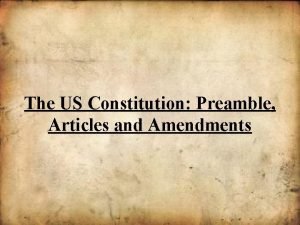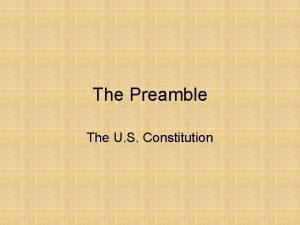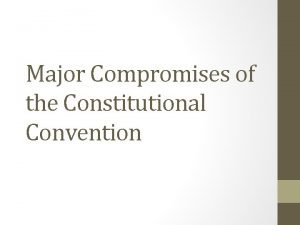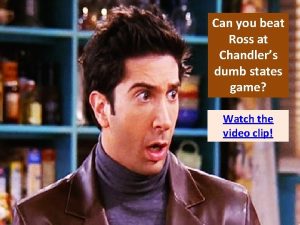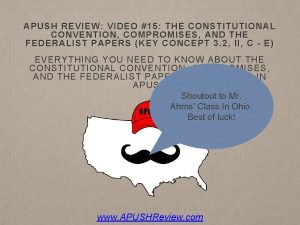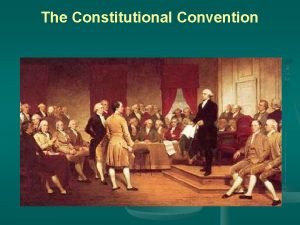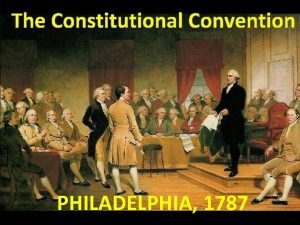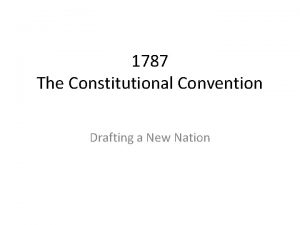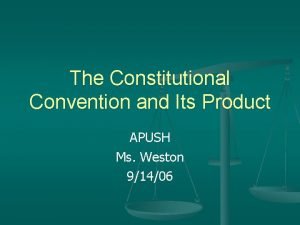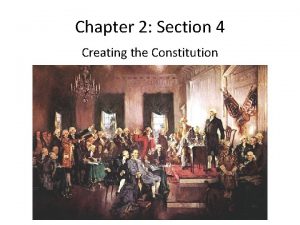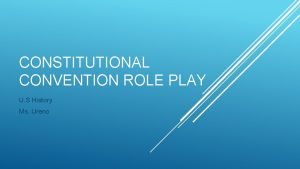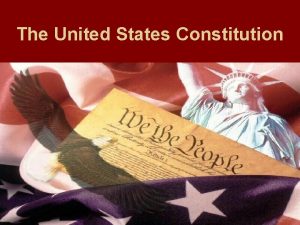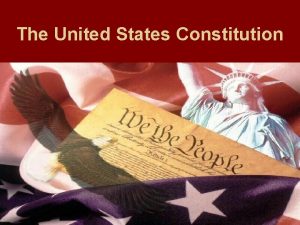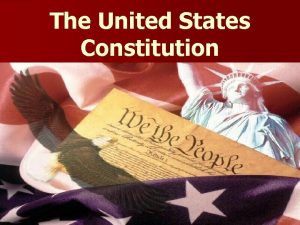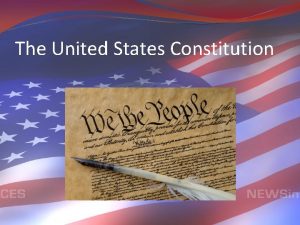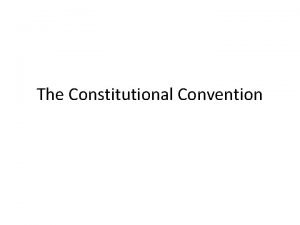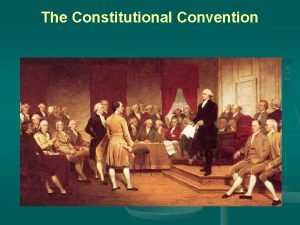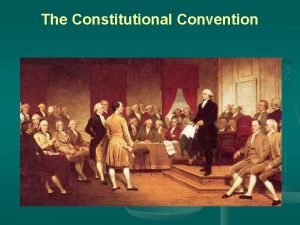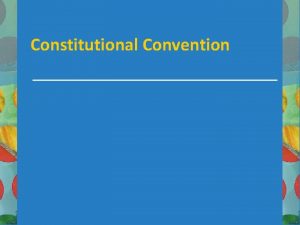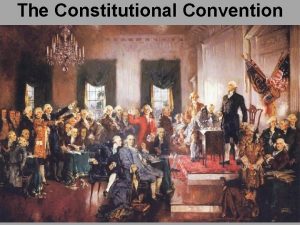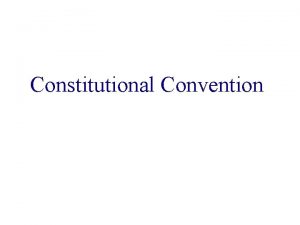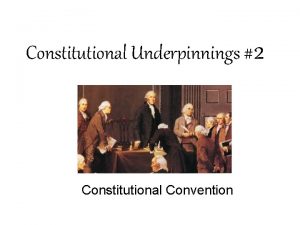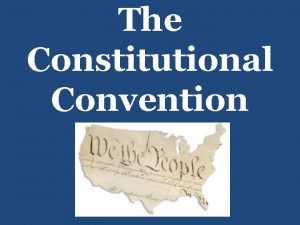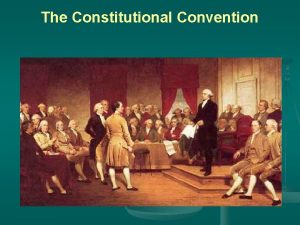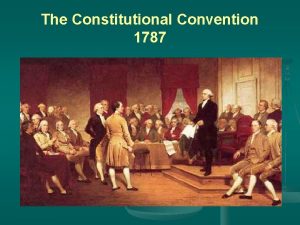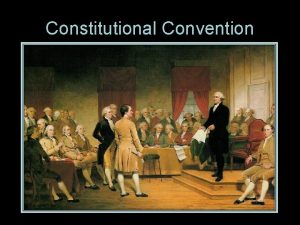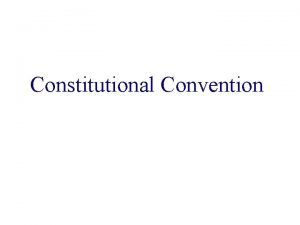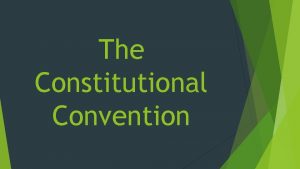Constitution of the United States Constitutional Convention Constitution




















- Slides: 20

Constitution of the United States

Constitutional Convention

Constitution • U. S Constitution is derived from Haudenosaunee (or Iroquois Confederacy, aka Six Nations) – Their “Great League of Peace” established a confederacy across the Kanienkehaka (Mohawk), Onondaga, Cayuga, Oneida, Seneca, and Tuscarora Nations – Each Nations maintained its leadership but common issues would be decided by a Grand Council of Chiefs

Constitution Iroquois Confederacy and the Great Law of Peace Restricts members from holding more than one o�ce in the Confederacy. Outlines processes to remove leaders within the Confederacy United States Constitution Article I, Section 6, also known as the Ineligibility Clause or the Emoluments Clause bars members of serving members of Congress from holding o�ces established by the federal government, while also baring members of the executive branch or judicial branch from serving in the U. S. House or Senate. Article II, Section 4 reads “The President, Vice President and all civil O�cers of the United States shall be removed from O�ce on Impeachment for, and the conviction of, Treason, Bribery, or other High Crimes and Misdemeanors. ”

Constitution Iroquois Confederacy and the Great Law of Peace Designates two branches of legislature with procedures for passing laws Delineates who has the power to declare war United States Constitution Article I, Section 1, or the Vesting Clauses, read “All legislative Powers herein granted shall be vested in a Congress of the United States, which shall consist of a Senate and House of Representatives. ” It goes on to outline their legislative powers. Article I, Section 8, Clause 11, also known as the War Powers Clause, gives Congress the power, “To declare War, grant Letters of Marque and Reprisal, and make Rules concerning Captures on Land Water; ”

Constitution Iroquois Confederacy and the Great Law of Peace Creates a balance of power between the Iroquois Confederacy and individual tribes United States Constitution The di�ering duties assigned to the three branches of the U. S. Government: Legislative (Congress), Executive (President), and Judicial (Supreme Court) act to balance and separate power in government.

Constitution • Benjamin Franklin referenced the Iroquois model as he presented his Plan of Union at the Albany Congress in 1754, attended by representatives of the Iroquois and the seven colonies • He invited the Great Council members of the Iroquois to address the Continental Congress in 1776

Indigenous Peoples and the U. S. Constitution • Congress has to power to “regulate Commerce with foreign Nations, and among the several States, and with the Indian Tribes” (Article 1, Section 8) • Supreme Court’s Marshall Trilogy – Johnson v. M’Intosh (1823) – Cherokee Nation v. Georgia (1831) – Worcester v. Georgia (1832)

Frontier Wars

Genocide • Indian Removal Acts of 1830 authorized the removal of Indigenous Peoples from their native territories to federal lands west of the Mississippi River • Led to the infamous Trail of Tears where over 4, 000 Cherokees died • By 1837, Jackson’s administration had removed 46, 000 Indigenous Peoples from their homeland opening over 22 million acres of land to white settlement

Sovereign Nation Treaty Making to Legislation • Cherokee Tobacco case (1870) – Supreme Court ruled that later congressional statutes trump earlier treaties – Court dealt a kill stroke to negotiating treaty policy making – Congress unilaterally ended the practice of treaty making with Indigenous Peoples the next year

Assimilation: 1887 -1933 • Indigenous sovereignty has since experienced increased limitations – Major Crimes Act of 1885 • Ex Parte Crow Dog (1883) – Dawes Act (1887) • to “civilize” Indigenous Peoples by removing their unique culture and heritage • Bureau of Indian Affairs, private organizations, and states began the widespread removal of children from indigenous families until the 1970 s

Devolution and Land Acquisition – Public Law 280 (1953) • Concurrent civil and criminal jurisdictions – Congress could extinguish the Indigenous title without being considering a ‘taking’ and having to provide just compensation • Tee-Hit-Ton v. United States (1955)

“Self-determination” and Devolution – Nixon administration unilaterally severed government’s obligations towards many tribes • thereby leaving them subject to state authority – Indian Civil Rights Act (1968) – Indian Gaming Regulatory Act (IGRA) (1988) • California v. Cabazon Band of Mission Indians (1987) • Seminole Tribe v. Florida (1996) – Indian Child Welfare Act (ICWA) (1978) • In Re Adoption of Baby Boy L (1982)

Taking Lands – City of Sherill, New York v. Oneida Indian Nation of New York (2005) • Repurchase of Indigenous lands does not restore tribal sovereignty to that land – Nebraska v. Parker (2016) • Government can take 50, 000 acres of reservation land without ‘diminishing’ Omaha reservation

Indigenous Peoples and the U. S. Constitution • Federal devolution to states – eliminates sovereignty – invites conflict – forces Indigenous Peoples to lobby legislatures and seek judicial redress in state courts

Indigenous Peoples and the U. S. Constitution • The shift from federal court jurisdiction to primarily state courts is problematic for Indigenous Peoples – Creates inconsistent precedent – Directly affects indigenous rights • Indigenous claims rarely win at state courts

Indigenous Peoples and the U. S. Constitution • Federal government support of indigenous claims does not improve likelihood to win • Original treaties with Indigenous Peoples does not improve likelihood of securing rights – 370 treaties between the U. S. and Indigenous Peoples • Constitution provides little protection for Indigenous Peoples

Indigenous Peoples and the U. S. Constitution • Indigenous Population – 576 federally recognized tribes in 2016 – 6. 8 million Indigenous Peoples • 2% of the population of the U. S. – More than 100, 000 Indigenous Peoples in Texas • Anadarko, Apache, Arapaho, Caddo, Cherokee, Cheyenne, Chickasaw, Comanche, Kawakawa, Kiowa, and Shawnee Peoples • Tigua of Ysleta del Sur Pueblo, Mescalero Apache, Tortugas Pueblo, Pima, Suma, Manso, Comanche, Raramuri

Indigenous Peoples and the U. S. Constitution • Thank you! • Questions? Rebecca A. Reid, Ph. D University of Texas at El Paso rareid@utep. edu
 Preamble of the constitution
Preamble of the constitution Preamble of the us constitution
Preamble of the us constitution Compromises at the constitutional convention
Compromises at the constitutional convention Constitutional convention definition
Constitutional convention definition Constitutional convention cartoon
Constitutional convention cartoon 3/5 compromise apush
3/5 compromise apush Constitutional convention begins
Constitutional convention begins Constitutional convention compromise
Constitutional convention compromise Constitutional convention
Constitutional convention Constitutional convention 1787
Constitutional convention 1787 Lesson 1 - the constitutional convention
Lesson 1 - the constitutional convention Constitutional convention article 5
Constitutional convention article 5 Constitutional convention compromise
Constitutional convention compromise Constitutional convention apush
Constitutional convention apush Constitutional convention definition
Constitutional convention definition Constitutional convention role play
Constitutional convention role play Class 7 dangerous goods
Class 7 dangerous goods Texas constitution vs us constitution
Texas constitution vs us constitution Nc constitution vs us constitution
Nc constitution vs us constitution Constitution what is constitution
Constitution what is constitution The constitution lesson 1 principles of the constitution
The constitution lesson 1 principles of the constitution
